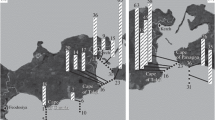Abstract
Data are presented on the content and composition of hydrocarbons (HC) (aliphatic, AHC and polyaromatic, PAH) in the filtered particulate matter and in the surface layer of the bottom sediments on the northern shelf of the Caspian Sea and related to the data on their content in the Volga River estuary. Because of the transformation and precipitation of anthropogenic and natural compounds, the HC composition in the particulate matter and bottom sediments undergoes transformations caused by the mixing of fresh and saline waters (in the bottom sediments, within the concentration ranges 70.4–4557.9 μ g/g for AHC and 3.8–4800 ng/g for PAH). It was found that the greatest concentrating of HC proceeds in the region of the avalanche sedimentation, and their content is independent of the grain-size type of the sediments. The anthropogenic HC (oil and pyrogenous) do not get over the marginal filter of the Volga River and do not pass to the open part of the sea.
Similar content being viewed by others
References
A. I. Agatova, K. B. Kirpichev, N. M. Lapina, et al., “Organic Matter in the Caspian Sea,” Okeanologiya 45(6), 841–850 (2005) [Oceanology 45 (6), 795–804 (2005)].
M. D. Kravchishina, Extended Abstract of Candidate Dissertation in Geology and Mineralogy (IO RAN, Moscow, 2007) [in Russian].
L. N. Kiryukhina, “Influence of the Grain-Size Composition of the Bottom Sediments on the Accumulation of Allochtonous Hydrocarbons,” Ekologiya Morya, No. 10, 36–39 (1982).
A. P. Lisitsyn, “Marginal Filter of the Ocean,” Okeanologiya 34(5), 735–747 (1994).
A. P. Lisitsyn, “Fluxes of Sedimentary Matter and Pollutants in the World Ocean and Methods for Global Monitoring,” in Landmarks of the Crisis (Nauka, Moscow, 2004), No. 2, pp. 133–193 [in Russian].
Methodic Guidelines. Determination of Pollutants in the Samples of Bottom Sediments. RD 52.10.556-95 (Gidrometeoizdat, Moscow, 1996) [in Russian].
Methods for Studying Organic Matter in the Ocean, Ed. by E. A. Romankevich (Nauka, Moscow, 1980) [in Russian].
I. A. Nemirovskaya, Hydrocarbons in the Ocean (Snow-Ice-Water-Particulate Matter—Bottom Sediments) (Nauchn. mir, Moscow, 2004) [in Russian].
I. A. Nemirovskaya, “Hydrocarbons of the White Sea (Ways of Supply, Forms of Migration, and Genesis),” Geokhimiya, No. 5, 542–554 (2005).
I. A. Nemirovskaya, V. F. Brekhovskikh, and V. D. Kazmiruk, “Aliphatic and Polyaromatic Hydrocarbons it Bottom Sediments of the Near-Mouth Seaside off the Volga River,” Vodn. Resur. 33(3), 300–310 (2006).
I. A. Nemirovskaya and S. A. Zaretskas, “Hydrocarbons in the Bottom Sediments of the Gulf of Riga,” Geokhimiya, No. 11, 1493–1501 (1992).
I. A. Nemirovskaya, V. P. Shevchenko, and A. Yu. Bogunov, “Hydrocarbons in the Bottom Sediments of the Severnaya Dvina River Estuary during the Spring Flood,” Vest. Arkhangel’skogo gosudarstvennogo universiteta. Ser. Prikladnaya geoekologiya, No. 66, pp. 137–150 (2006).
F. Ya. Rovinskii, T. A. Teplitskaya, and T. A. Alekseeva, Background Monitoring of Polycyclic Aromatic Hydrocarbons (Gidrometeoizdat, Leningrad, 1988) [in Russian].
E. A. Romankevich, Geochemistry of Organic Matter in the Ocean (Nauka, Moscow, 1977) [in Russian].
T. A. Shiganova, V. V. Sapozhnikov, E. I. Musaeva, et al., “Factors Determining the Conditions of Distribution and Quantitative Characteristics of the Ctenophore Mnemiopsis leidyi in the North Caspian,” Okeanologiya 43(5), 716–733 (2003).
I. Bouloubassi and A. Saliot, “Investigation of Anthropogenic and Natural Organic Inputs in Estuarine Sediments Using Hydrocarbon Markers (NAN, LAB, PAH),” Oceanol. Acta 16, 145–161 (1993).
L. Culotta, C. De Stefano, A. Gianguzza, et al., “The PAH Composition of Surface Sediments from Stagnone Coastal Lagoon, Marsalla (Italy),” Mar. Chem. 99(1–7), 117–127 (2006).
H. J. Dumont, “Caspian Lake: History, Biota, Structure, and Function,” Limnol. Oceanogr. 43, 44–52 (1998).
I. Efimov, “The Oil and Gas Resource Base of the Caspian Region,” J. of Petroleum Science Eng. 28, 157–159 (2000).
GESAMP (Joint Group of Experts on the Scientific Aspects of Marine Pollution), Impact of Oil and Related Chemicals on the Marine Environment (Reports and Studies, No. 50) (IMO, London, 1993).
W-L. Jeng, “Higher Plant n-Alkane Average Chain Length As an Indicator of Petrogenic Hydrocarbons Contamination in Marine Sediments,” Mar. Chem. 102(3–4), 242–251 (2006).
M. C. Kennicutt and L. M. Jeffrey, “Chemical and GCMS Characterization of Marine Dissolved Lipids,” Mar. Chem., No. 10, 367–387 (1981).
E. Lipiatou, J. Marty, and A. Saliot, “Sediment Trap Fluxes and Transport of Polycyclic Aromatic Hydrocarbons in the Mediterranean Sea,” Mar. Chem. 44, 43–54 (1993).
D. R. Oros and J. M. Ross, “Polycyclic Aromatic Hydrocarbons in Estuary sediments,” Mar. Chem. 86, 169–184 (2004) (San Francisco, 2004).
I. Tolosa, S. Mora, M. R. Sheikholeslami, J. P. Villeneuve, et al., “Aliphatic and Aromatic Hydrocarbons in Coastal Caspian Sea Sediments,” Mar. Pollut. Bull. 48, 44–60 (2004).
M. J. Venkatesan and I. R. Kaplan, “The Lipid Geochemistry of Antarctic Marine Sediments: Bransfield Strait,” Mar. Chem. 21, 347–375 (1987).
H. J. Winkels, S. B. Kroonenberg, M. Y. Lychagin, et al., “Geochronology of Priority Pollutants in Sedimentation Zones of the Volga and Danube Delta in Comparison with the Rhone Delta,” Applied Geochem. 13, 581–591 (1998).
Author information
Authors and Affiliations
Corresponding author
Additional information
Original Russian Text © I.A. Nemirovskaya, V.F. Brekhovskikh, 2008, published in Okeanologiya, 2008, Vol. 48, No. 1, pp. 48–58.
Rights and permissions
About this article
Cite this article
Nemirovskaya, I.A., Brekhovskikh, V.F. Origin of hydrocarbons in the particulate matter and bottom sediments of the northern shelf of the Caspian Sea. Oceanology 48, 43–53 (2008). https://doi.org/10.1134/S0001437008010062
Received:
Accepted:
Published:
Issue Date:
DOI: https://doi.org/10.1134/S0001437008010062




